WORLD CLASS COACHING
Club Curriculum U11/12 Season
By Tony Englund
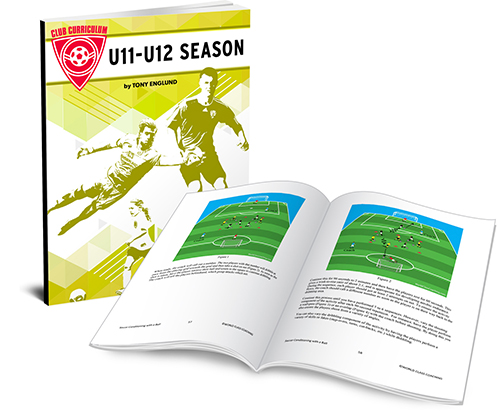
TABLE OF CONTENTS
Part Four
ATTACKING SESSIONS
ABOUT THE AUTHOR
Training Session#18: Finishing
Introduction
This collection of finishing exercises does not represent a free standing session. These training environments are proven to be effective and fun means of improving finishing.
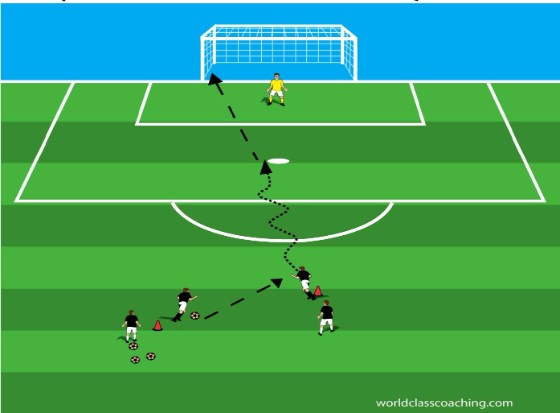
Pressure shooting - 1/3 field
Two lines form at the cones 30 yards from goal as indicated in the diagram. Note that the cones are staggered to give the attackers an advantage. The first player in the defending line passes to the front foot (or into space in front of her) and then the defender pressures and attempts to win the ball from the attacker, who sprints to finish. If the defender wins the ball, she tries to score.
After the shot is taken, the attacker retrieves the ball and jogs back to and joins the defender’s line. The defender joins the attackers line. Encourage the attacker in this exercise to take a straight angle with speed to the goal (there is a tendency for the attackers to veer to their right to avoid pressure) and adopt a good shooting angle. The attacker should also get a good look at the goalkeeper’s position after her set up touch and see if she can shoot (low, back post is best) while the goalkeeper is trying to close her down (catch the goalkeeper moving forward).
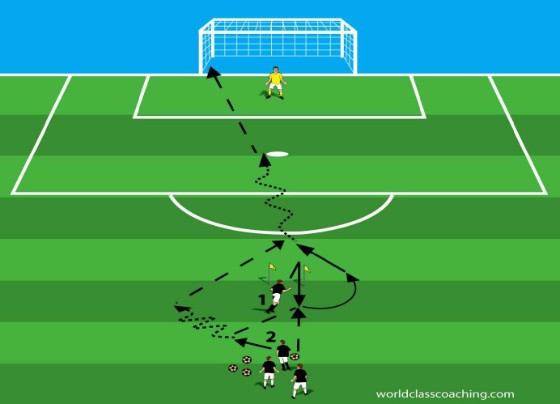
Lay-off and penetrate - 1/3 field
Player 1 makes a hard run into the gate (representing the opposing back line) and then checks back toward the ball. Player 2 passes in to the feet of player 1, who lays the ball off to one side for player 2 and then makes a curved run in the opposite direction. Player 2 plays the ball in behind the opposing back line for player 1 to run onto and dribble to finish. Player 2 then makes a check run through the gate and the sequence repeats.
Coaching Points
• Proper pace and location in passing: There should be rhythm in the passing to provide some realism in both the speed of play and also the timing of the runs. The lay-off pass in particular must be played at an angle that allows the receiving player to easily control the ball and develop a good passing window for the through pass.
• Quality runs: The check run must be made with conviction in both directions if it is to freeze and pull apart the opposing back line in a game situation. Similarly, the curved run prior to penetration must be made at speed and also with an eye toward being able to look over the inside shoulder to time the run to stay on-side and choose the proper point to get in behind the defense.
• Communication: The supporting player should demand the back-pass and also urge the runner to get in behind the defense. Similarly, the runner should demand the ball be played to her feet to initiate the sequence and then demand the ball be played in behind to complete the combination.
Shoot-keep-retrieve - 2 goals 22 yards apart
Divide the group into two teams gathered on opposite posts of the two goals with large supplies of balls. One team supplies a goalkeeper for the first shot by the other team. Each player shoots, then plays goalkeeper for one shot by an opponent and then retrieves a ball and gets back in line. Each player is allowed two touches (a set touch and the shooting touch) and the first touch must occur after the previous opponent’s shot (so that the player can hustle over to play goalkeeper). This is a fast-moving, fun finishing environment. Keep track of score and play to 20 goals.
Variations
• After each shot, the players must drop down onto their front sides and recover before playing goalkeeper.
• Require a certain type of shot (i.e. off-foot; low, driven ball; shot under the bar)
• Number the corners of the goal 1-4. The shooters must call out the number of the corner they will play before striking the ball.
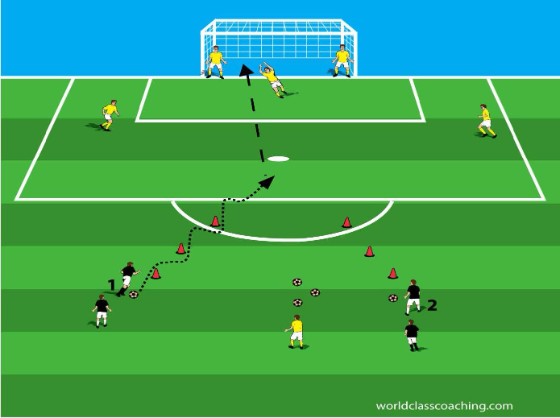
Supplemental goalkeepers - 30 yard area before goal
Divide the group into two teams. One team will provide two ‘supplemental’ goalkeepers, who must keep a hand on the back side of their respective posts and cannot use their hands, but otherwise try to assist the goalkeeper in blocking shots. The remaining players on the defending team are charged with organizing to keep a steady ball supply for the attackers.
The attackers each have a ball and they are split in lines behind the cone lines. Alternating sides, the attackers must dribble through the cones at speed and then they get one touch before shooting at goal. After shooting, they get another ball and change lines. When the attacker on the opposite side clears the last cone on the dribble, the next attacker can start to navigate the cone line. Players in the left-side line must shoot with their right foot, and those approaching from the right must use their left foot (increases the shooting angle).
Play for ninety seconds and then change the supplemental goalkeepers and play for ninety seconds again. Keep track of the goals scored. After two rounds, the teams change positions. The team to score the most goals wins.
Training Session#19: Second Defender
Introduction
Session #19 introduces the role of the second defender. Players learn to recognize the importance of providing cover and working in tandem to limit attackers’ options.
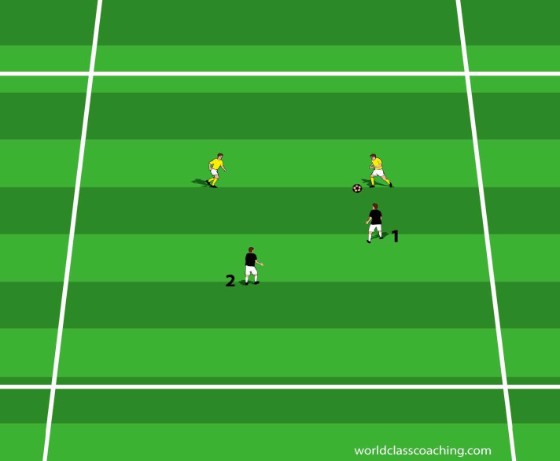
2 vs. 2 to end lines - 12x15 yard areas
Play 2 vs. 2 to end lines. Play is initiated by passes from alternating ends. Use a walk through to demonstrate the tactical roles of the first and second defender.
• The first defender is the player nearest the ball. This player is responsible for pressurizing the ball and making the movements and options for the player in possession predictable.
• The second defender adopts a covering position (as shown above) off of the shoulder and behind the first defender (a good image for players regarding the distance is about the length of a corner flag). The second defender’s responsibility is to communicate with the first defender as to which way to show the ball (toward cover) and also to be in position to become the first defender if her partner is beaten.
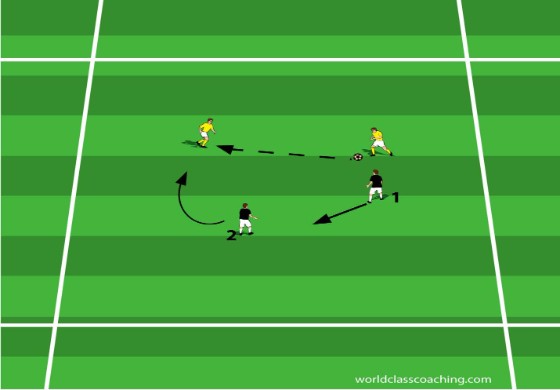
The diagram above shows how the players’ roles shift as the ball is passed from one opponent to the other.
• Note that with the shift in roles, the new first defender works to force the ball back toward her support.
• Stress to the players that they look to each other as they shift (to assure that they are in sync as they shift roles).
• At this early stage, demonstrate but do not expect that players will call out (as second defenders) the side to which the ball should be channeled (left or right).
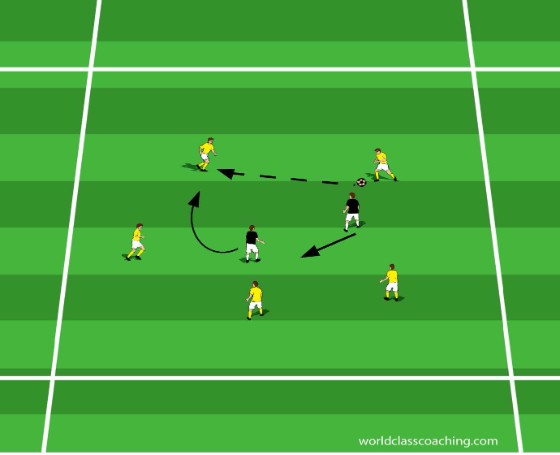
5 vs 2 - 10x10 yard areas
This is a popular environment for both a possession warm-up and also training first and second defender roles. The five attackers attempt to keep possession and whenever possible split the two defenders with a pass. The two defenders work to isolate the ball and sort out their defending roles with an eye toward winning the ball. When the ball is won, the attacker causing the turnover (last to touch the ball) takes the place of the defender who won the ball. Similarly, if the ball leaves the area, the attacker playing the ball out takes the place of one of the defenders. In this way, the defenders should be rotated often enough to keep them fresh.
Coach Points
• The strategy for the defenders is to apply pressure but be composed, looking for a poor pass or long touch that allows them to close down and win the ball. It is instructive to try to get the defenders to think in terms of trying to make the attackers play short passes and pin them in one area, getting ahead of the ball and being sure to take away any potential split pass (note the second defender’s position above, cutting the through pass). In any case, the constant variations in direction of play and role changes by the two defenders require constant communication and good defensive vision.
Variations
• Require the attackers to move to a different part of the area (and shift to reform their circle) after they pass. This adds pressure to the attackers and also creates traffic for the defenders to read.
• Each pair of defenders remains in the middle for one minute. They earn one point for each ball they win or knock out of the grid. Give every player an opportunity to play in the middle and check to see which pair earned the most points.
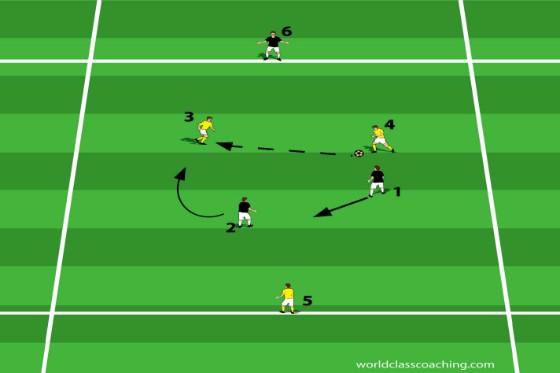
2 vs 2 + 2 - 12x20 yard grids
Players 1 and 2 play against players 3 and 4, attempting to play either target player on the opposite end of the grid. 1 and 2 can use 5 as support pass option and 1 and 2 try to combine to play in to 6. 3 and 4 can use 6 for support and they try to play through to 5. Play is continuous and the middle pairs rotate out after three minutes.
Coach Points
• This is a narrow, directional playing environment, ideal for further familiarizing players with the first and second defender roles.
• Encourage the attackers to play directly to the target when possible. This adjustment will compel the defenders to keep pressure on the ball to avoid the early through pass.
8 vs. 8 game - ½ field
Close the session with an 8v8 game on ½ field to full-sized goals. Award a point for a goal and also a point for good examples of the first and second defender working in tandem.
Training Session#20: Shadow Play: Attacking Patterns- 1-3-3-1
Introduction
This session familiarizes players with the team shape in possession and gives ideas as to how the team can transition into and complete the attacking phase. Shadow play is not realistic training (no resistance) and should only be used for brief periods with young players, but it is a good way to help players understand their roles and how they connect with their team members in possession.
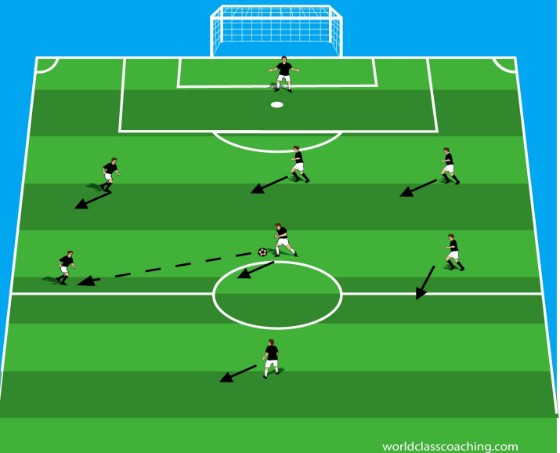
Basic shape and passing patterns - Full Field
Players ping the ball around as shown, learning the appropriate angles and passing relationships. Explain to the players that every time the ball moves, all 8 players must adjust their positions. The coach can use this setting to freeze the team and make adjustments.
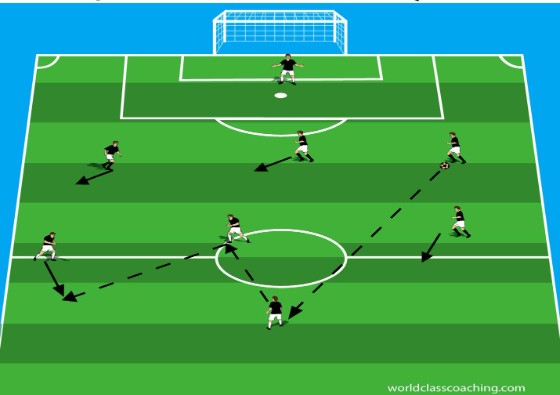
Transition through the striker 1 Full Field
One of the most common points of transition in this system is to play into the striker’s feet and then lay the ball off for the central or flank midfielders while penetrating runs develop. Because of the single striker deployed in this system, it is essential that the player be mobile and make an effort to stay in line with the ball when the team is in possession.
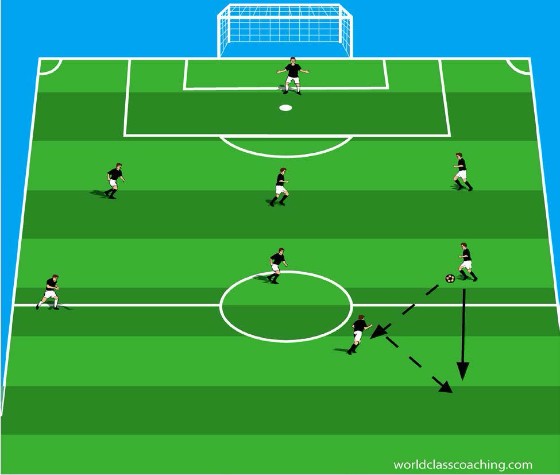
Transition through the striker 2 - Full Field
Here, the striker checks to the ball as the wing midfielder receives, and the two complete a 1-2 to get the wing midfielder in behind the defense.
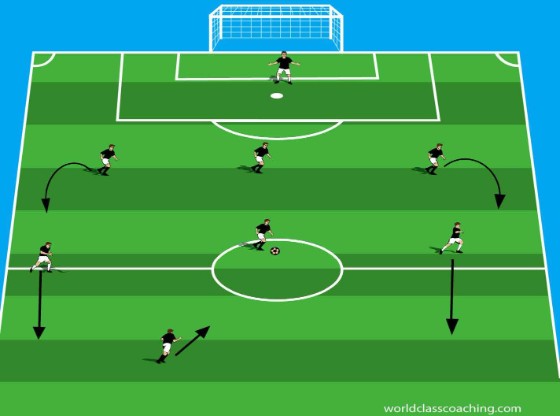
Central attacking options - Full Field
The central midfielder has the ball faced up entering the middle third. The outside backs move higher and wider and the wing midfielders make runs forward. The center striker can check to the ball if there is any pressure (shown) or make an angled, penetrating run if the central midfielder has room to dribble.
Training Session#21: Shadow Play: Attacking Patterns- 1-2-3-2
Introduction
This session familiarizes players with the team shape in possession and gives ideas as to how the team can transition into and complete the attacking phase. Shadow play is not realistic training (no resistance) and should only be used for brief periods with young players, but it is a good way to help players understand their roles and how they connect with their team members in possession.
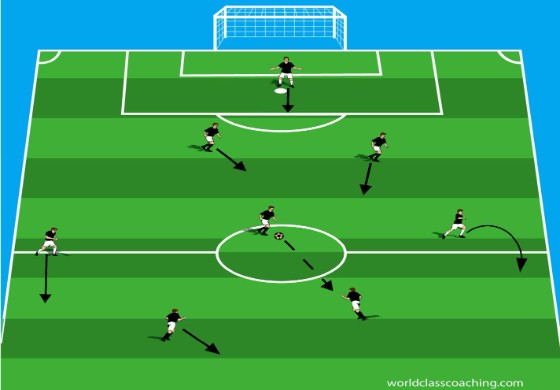
Basic shape and passing patterns - Full Field
Players ping the ball around as shown, learning the appropriate angles and passing relationships. Explain to the players that every time the ball moves, all 8 players must adjust their positions. The coach can use this setting to freeze the team and make adjustments. Note that with only two backs, it may be difficult to play backward and that when one defender has the ball, the other moves into a supporting position.
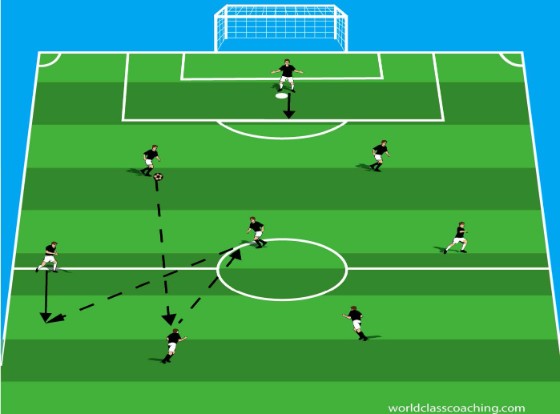
Combination to release the outside midfielder - Full Field
The right back passes into the feet of the checking right forward, who lays the ball off for the central midfielder. The right midfielder makes a determined run into space, where the central midfielder passes the ball for her.
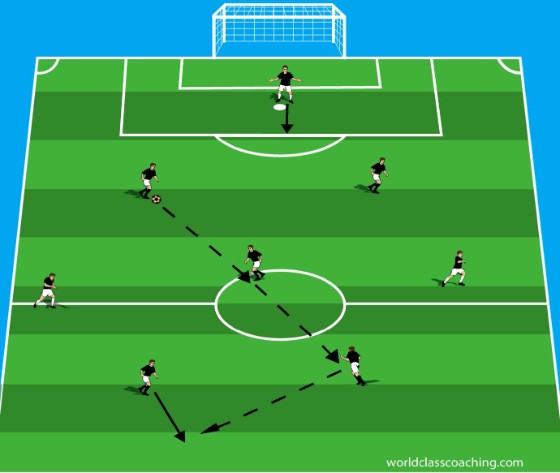
Central attack through the two forwards - Full Field
The right back passes into the feet of the central midfielder who turns and plays the feet of the left forward. The right forward makes an angled run in behind the defense and her partner passes into space for her.
Training Session#22: Technique Olympics
Introduction
This series of technical challenges can serve as a fun team competition or as a periodic assessment of players’ technical progress.
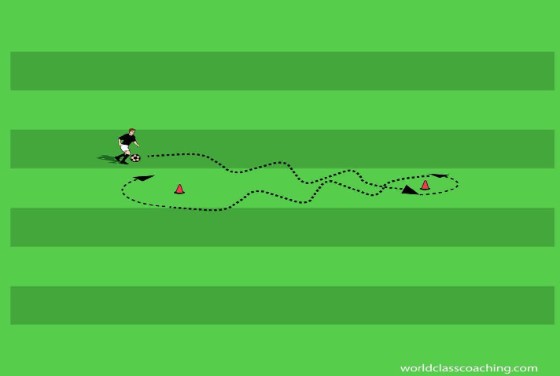
Figure 8 Dribbling - 10x3 yard areas
The player dribbles in a figure 8 pattern around the cones, using the inside of the foot for each turn. Which player can complete the most circuits in one minute?
Progression
• All turns are made with the outside of the foot.
Body part juggling
Each player has a ball. The challenge here is to try to utilize as many body parts from the list below in each juggling sequence. Players earn a point for every different surface used in each sequence, but not for redundant use of a given surface.
1. Head
2. Left shoulder
3. Right shoulder
4. Chest
5. Right thigh
6. Left thigh
7. Top of right foot
8. Top of left foot
9. Inside of right foot
10. Inside of left foot
11. Outside of right foot
12. Outside of left foot
13. Right heel
14. Left heel
Which player earns the best score?
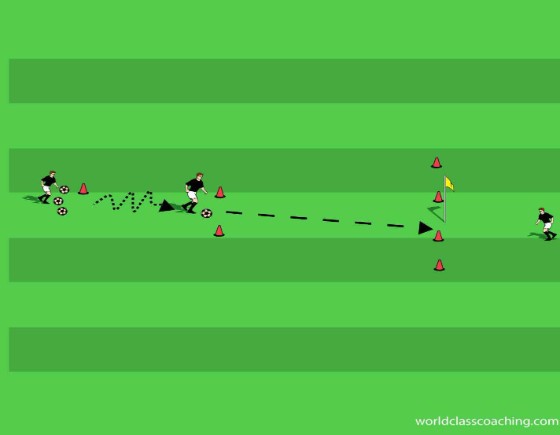
Passing accuracy - 10x10 yard areas
The active player dribbles to the cone line and passes, attempting to push the ball between the flag and the nearest cone on either side (2 points). A pass between the first and second cone on either side is worth a single point. Any pass outside of the flanking cones does not earn a point. The active player then runs back to retrieve another ball and tries again. The two resting players are responsible for maintaining a ball supply for the active player. Play for one minute and then change roles.
Variation
• All passing is with the ‘off’ foot.
Which player earns the highest score?
Head juggling
Each player has a ball. Which player can complete the most consecutive headers in one sequence? Play for one minute and check scores.
Variation
• Tally total headers over one minute.
Long passing accuracy - Two 10x10 yard grids twenty yards apart
Players work in pairs with a ball. One player stands in each grid. Players earn a point for every ball they can long pass in the air into their partner’s grid. Play for three minutes.
Variations
• All passes must be made with the ‘off’ foot.
• Give another point for proper receiving touches that keep the ball inside the receiving player’s grid.
Training Session #23: Attacking Set Plays
Introduction
For any competitive team, regardless of the chosen system of play, effective attacking set plays are critical to the team’s success. This session is not intended to be a free-standing training session, but rather a collection of creative and effective throw in, corner kick, direct and indirect free kick plays.
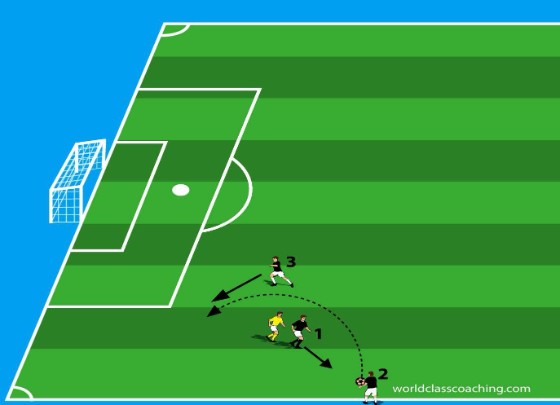
Decoy throw-in play
Player 1 checks back toward the ball while player 3 sprints into the space behind player 1 as player 2 throws the ball for player 2 to run onto. Player 1 needs to be very demonstrative in demanding the ball as she checks to the ball so that the defender will be pulled out of position and player 3 can find space to run into.
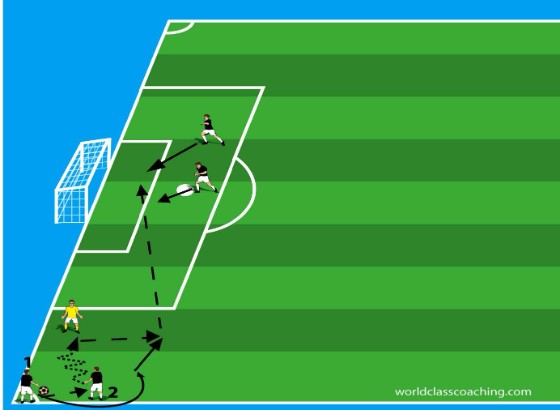
Short corner kick play
Player 1 and player 2 are at the corner. Player 1 passes to player 2 and then overlaps her. Player 2 dribbles at the defender. Player 2 can either pass to player 1 or fake the pass and dribble past the defender. Either way, the ball is crossed for the coordinated runs before goal, or shot at goal if the runner can achieve a good angle and distance from which to attempt to score.
Considerations
• If an opponent is closer than ten yards, the players should ask the official to set the proper distance before commencing their movement.
• Note that if the opponents send two players to defend this play, the attackers change the play to serve a ball into the area.
• A useful variation to this play is to place a single player at the corner to start and then have a runner come from the crowded area in front of the goal and check to the ball to play a 1-2 with the server. In this way, it is both easier to disguise the short corner and also create a better angle and distance for the serve into the area.
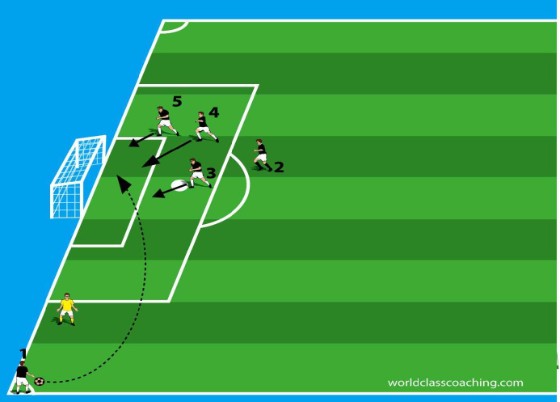
Wave corner kick play
Player 1 is at the corner. Players 2, 3, 4, and 5 gather at the top of the box and just beyond the back post. At a signal from player 1, the runners close on the goal and finish the serve from the corner. Note the varied runs that create an arc in which the ball is likely to fall for one of the runners. Also note that player 2 remains near the top of the box, available to play a ball that pops out or a miss-hit off of the corner.
Considerations
• The starting position for the runs can be varied. Some teams group the runners together, making the individual players difficult to track. Other teams put the players together but then have them mix about until just seconds before the kick, making the runners even more difficult to sort out. Finally, some coaches like to send the runners in stages, hoping to drag defenders out of position. Regardless, it is important the coach find a rhythm and pattern that is predictable and successful for the team.
• The coach can set the runs to meet the anticipated service to a particular zone (often the back half of the goal and 5-7 yards from the goal). It is advisable to have at least one runner getting into the near post area to find a short or low serve (advanced teams often target this player to flick the ball to the targets at the back post). Similarly, one runner should attempt to get to the goalkeeper to disrupt her concentration on any ball served to a point where she can play it), and one player should seal off the area outside the back post to frame in any ball that gets through the area.
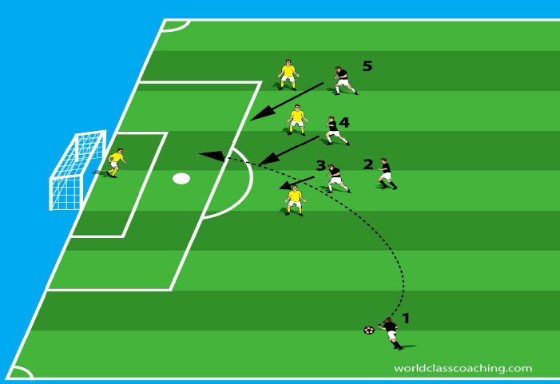
Distance free kick play
This is the classic play to take advantage of a free kick opportunity from a distance beyond which a direct shot at goal can be attempted. Player 1 is at the ball. Several target players line up along the defensive restraining line. Player 1 serves the ball behind the defensive restraining line, but also far enough from the goal to prevent the goalkeeper grabbing the serve, for the runners to find and finish.
Considerations:
• The runs should be coordinated in such a way as to assure that a player gets end-line to prevent the ball going out for a goal kick and at least one player should make an effort to challenge an advancing goalkeeper for the ball as well.
• The runners should not all start on the defensive restraining line where they are easy to mark and where their runs can be disrupted by the defenders. Rather, it is useful to have some runners start in wider positions (and several yards on-side) and approach the restraining line at full speed (and out of the vision of the defenders as they focus on the ball) as the ball is served.
• Another tactic to frustrate markers is to have a runner(s) stand in an off-side position during the set-up of the play and then check sharply on-side just before the ball is struck.
• Finally, at high levels teams often run switches, with players crossing (and, cynically, picking off defenders) as they run, making it difficult to isolate a particular defender on a dangerous attacker.
Training Session#24: Defending set-pieces.
Introduction
Defending set plays requires considerable preparation, first by the coach in deciding the framework with which the team will confront opponents’ efforts to finish and then in the team setting, to assure that every player instinctively understands their roles and will react properly and consistently under pressure. This session lays out the possibilities for defending at set-pieces, and also suggests ways to comb defending set-pieces into the training environment.
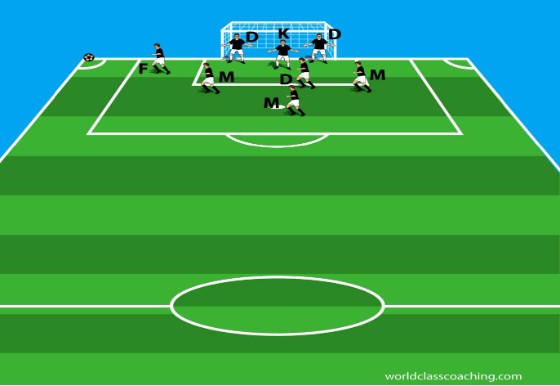
Defending corner kicks - 1/3 field
Corner kicks offer a very strong chance to score at any level, and the coach preparing her team to defend in these situations must first answer several important questions:
1. Will the team employ zone or man-marking or a mix?
2. How many players will defend?
3. How well does the team defend in the air (the answer to this question impacts the answer to #2)?
4. How big an area can be assigned to the goalkeeper (i.e. how strong is the goalkeeper in the air and handling the ball in traffic)?
5. Other considerations (opponents’ efficiency at corners, weather, game situation).
Recommendation
• Deploy a mix of zonal defending and man-marking as shown, placing players at each post (note the near-side defender’s up-field-facing position before the kick, freeing the goalkeeper’s vision. If instructed to clear the ball by the goalkeeper, she steps out and plays the ball away); the center back and the goalkeeper to control the six-yard box; the three midfielders are placed in a stacked zone across the top of the six-yard box. Any ball that would fall in front of any one of them is their responsibility. The forward is responsible for dealing with any potential short corner (many teams send one player to the corner to deal with this possibility and distract the kicker. It’s even better to send a second player- a midfielder- to play 2 vs. 2 against a short corner). A midfielder can be detailed to mark a particularly dangerous opponent.
• Train a confident, aggressive mentality into the group for defending corners. Playing passively will lead to goals being conceded, whereas a loud, active and determined defending group provides an intimidating environment for the attackers and also gives the defenders a psychological sense of purpose.
• Clearing out. The team hunts the ball once the serve is struck. When the ball is played away from the goal, all but the two backs on the posts must pursue and pressure the ball. When the ball leaves the box, the two players on the posts sprint forward. Keeping them in gives extra protection in the goal area while the ball is still in a dangerous position. However, when the ball leaves the area, the danger decreases and the retention of those players on the posts both eliminates the possibility of an offside call against the attackers and detracts from the width of the defensive back line in transition.
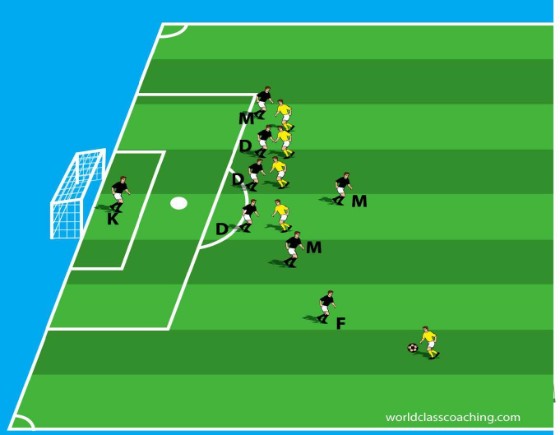
Defending direct or indirect free kicks: Beyond shooting range - 2/3 field
When the opponent earns a free kick from beyond shooting range, the defending group may still employ a small wall (1-2 players) to distract the server and additional players may remain in the area to deal with short options for the attackers. The remainder of the team organize a restraining line to develop space for the goalkeeper to handle a long serve toward the area. Players along the restraining line should get shoulder-on with an attacker, with the idea that the contact will wreck the timing of their run into the area and also allow the defender to arrive first. If possible, at least one central defender should be left free.
Some teams, particularly at the youth level, prefer to have this player leave the line and run into the area just before the ball is struck to give the player an advantage in the race to the ball. This decision may wreck the offside protection offered by holding the line, but it also gives the defender a major advantage. Regardless, the goalkeeper must make an early call as to whether she will handle the ball or if the team will need to clear the serve, and once the ball is cleared, the entire team must work to get forward and recover their shape as quickly as possible.
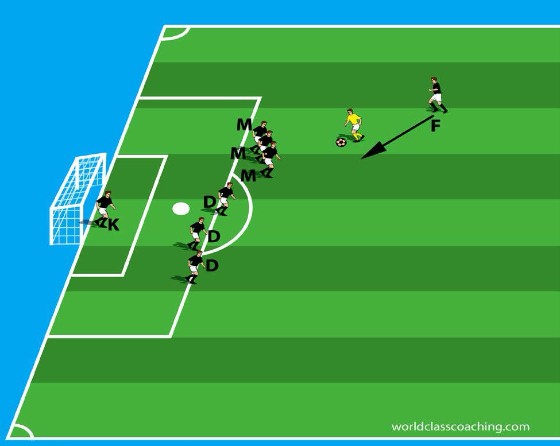
Defending direct or indirect free kicks: Shooting range - 1/3 field
Direct free kicks from around the edge of the 18-yard box and at angles where shots can be taken require special treatment from a defensive perspective. The coach should give parameters for the number of players to be placed in the wall (from 1-2 for wide angles and up to 4-5 for shots from straight on). Typically the midfielders and/or forward(s)form the wall. The coach can instruct the goalkeeper to arrange the wall or a forward can perform the same duty so that the goalkeeper can focus exclusively on the ball. Either way, the wall should be arranged with the tallest player on the near post (this area is most in danger, as the goalkeeper begins in the back half of the goal) and shorter players filling out the line.
It is critical that the coach work out the process for the placement of the wall so that it can be done in just a few seconds under pressure. If the goalkeeper will set the wall, the end player (tallest) should either turn and face her or look over her outside shoulder to see her instructions, all the while grasping the next player in the wall to assure that movement is synchronized. The end player, as a rule, should be at least the width of one person outside the post to deter attempts to bend the ball around the wall. The defenders mark opponents around the wall, picking up the most dangerous players first and holding a line nearly as high as the wall itself (to minimize traffic for the goalkeeper in trying to make the save).
Tactical considerations
• In the modern game, most defending teams put a player(s) 2-3 yards in front of the ball to wreck any idea of taking the kick before the wall can be set. By the rules of the game, this is meant to be rewarded with a yellow card, but it is almost universal that there is no card and the attacker requests the proper 10-yard spacing. Once the official steps in to set the wall at the proper distance, play is only restarted with the referee’s whistle.
• Use of a ‘bullet.’ Although more common in indirect free kick situations, some teams send a player off of the end of the wall running at the ball (‘bullet’) just before it is struck. Once again, technically-speaking this should result in a yellow card, but most often it results in a blocked kick. Many coaches only employ a ‘bullet(s)’ only in indirect kick situations.
Indirect free kick in the area - 18-yard box
Occasionally, a team will concede an indirect free kick in the area. This is a very dangerous situation, particularly if the placement of the ball is close to the goal mouth (as shown). In this case, many coaches place the entire team on the goal line, splitting the wall around the goalkeeper. Remind players that since this is an indirect kick situation, the opponents will need to take a touch before shooting. When that first touch is taken, the entire wall (some coaches leave players on the posts) sprints forward, keeping in their lanes, hoping to block the shot. Indirect kicks from sharp angles can be played more like a corner kick, with defenders on the posts and a combination of zone an man-marking in front of goal.
Sources and Recommended Reading
Alagich, Richard. Soccer: Winning Through Technique and Tactics. New York, NY: McGraw-Hill, 1996.
Dorrance, Anson. WCC Clinic Field Session.
Fairclough, Paul. Soccer Strategies. Buffalo, NY: Firefly Books, 2009.
Fleck, Tom, and Ron Quinn. The Baffled Parents’ Guide to Great Soccer Drills. Camden, ME: Ragged Mountain Press, 2002.
Galustian, Alf and Charlie Cooke. A New Era: A Coerver Coaching Masterclass Series. Sportsmethod, 1998.
Green, Shaun. Soccer Made Easy: Coaching 9-12 Year Olds. Spring City, PA: Reedswain, 2002.
Gregg, Lauren. The Champion Within: Training for Excellence. Burlington, NC: JTC Sports, 1999.
Harrison, Wayne. Full Season Training Program: A Complete Season of Training Sessions for a Competitive U12 Team. Leawood, KS: World Class Coaching, 2007.
Kormelink, Henny and Tjeu Seeverens. Developing Players the Dutch Way. Spring City, PA: Reedswain, 1996.
NSCAA. State Diploma. Course materials.
NSCAA. Regional Diploma. Course materials.
NSCAA. Advanced Regional Diploma. Course materials.
NSCAA. Coaching Soccer. Edited by Tim Schum. Indianapolis, IN: Masters Press, 1996.
Rees, Roy. The Manual of Soccer Coaching. Spring City, PA: Reedswain, 1995.
Rees, Roy and Cor Van Der Meer. Coaching Soccer Successfully. Champaign, IL: Human Kinetics, 1997.
Success in Soccer (DFB). Basic Training:Techniques and Tactics for Developing the Serious Player. Munster, Germany: Philippka Sportverlag, 2002.
Success in Soccer (DFB). Modern Youth Training: The Complete Guide to Soccer for Kids. Munster, Germany: Philippka Sportverlag, 2006.
Stoop, Tino. Coaching Under 12’s: A Complete Coaching Course. Spring City, PA: Reedswain, 2003.
United States Soccer Federation. Soccer: How to Play the Game: The Official Playing and Coaching Manual of the United States Soccer Federation. New York, NY: Universe Publishing, 1999.
Wein, Horst. Developing Game Intelligence. Spring City, PA: Reedswain, 2004.
Wilkinson, Roger, and Mick Critchell. 300 Innovative Soccer Drills for Total Player Development. Spring City, PA: Reedswain, 2000.
About the Author
Tony Englund is the Assistant Director of Coaching at St. Croix Soccer Club. Tony has earned more than a dozen diplomas from the National Soccer Coaches’ Association of America, including the Premier, National Goalkeeping and Director of Coaching awards and he serves as an Associate Staff Coach for that organization. Tony is a frequent presenter at high-level coaching clinics. He has served as Director of Coaching and Player Development with three Minnesota clubs and has more than twenty years’ experience as a successful club, high school and college head coach. His teams have repeatedly earned promotion to the highest levels of state and Midwest Regional League play and won multiple state championships, premier league titles and consistent regional rankings. He is the author of nine books published by WORLD CLASS COACHING.


